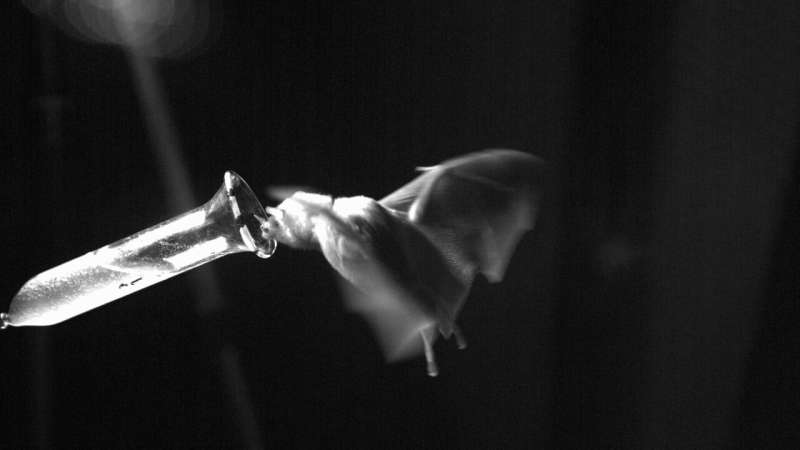Hovering flight, seen in animals ranging from dragonflies to hummingbirds, is a remarkable and fascinating form of movement. It requires a combination of factors such as size, muscular strength, and wing structure. A recent study conducted by Dartmouth College found that nectar-feeding bats, which hover while they feed on flowers, have exceptionally long whiskers in comparison to other bat species. This unique feature is critical for their aerial maneuvering. The findings were published in the journal Proceedings of the Royal Society B.
The researchers employed high-speed cameras to document the role of the rigid hairs extending from the faces of nectar-eating bats. These hairs give the bats improved spatial information that assists them as they make rapid movements toward the flowers, where they feed within a matter of seconds without touching the ground.
To lead author Eran Amichai, a postdoctoral researcher in biological sciences at Dartmouth College who focuses on bat echolocation, the whiskers of nectar-feeding bats play a vital role in their hovering behavior. These stiff hairs serve as sensory organs, providing the brain with important information for optimizing the bats' flight. The relationship between the form and function of these whiskers represents an interesting intersection between sensory biology and bio-kinematics.
Bat Tongue and Whiskers
The co-authors of the study include David Boerma, a postdoctoral fellow at the American Museum of Natural History, Rachel Page, an animal behaviorist at the Smithsonian Tropical Research Institute in Panama, Sharon Swartz, a professor of biology and engineering at Brown University, and Hannah ter Hofstede, a former assistant professor of biological sciences at Dartmouth College and currently at the University of Windsor in Canada.
The team conducted their study at the Smithsonian Tropical Research Institute, where they recorded Pallas's long-tongued bats, which have the highest metabolism of any mammal, as they fed from hand-crafted glass flowers designed to mimic the plants they typically feed from. High-speed infrared cameras captured images and videos of the bats as they approached the glass flowers and inserted their muzzles and tongues to drink the nectar. These feedings usually lasted between half a second to one second, as reported by Phys.
The scientists discovered that bats with trimmed whiskers were less skillful and precise in their feeding and flight compared to bats with unaltered whiskers. The bats with clipped whiskers were kept for a few days until their whiskers grew back, after which they were released back into the jungle. Amichai stated that although clipping the whiskers didn't prevent the bats from feeding, it made the process less smooth. He compared it to a gymnast scoring lower, going from a 9.8 to an 8.5. Amichai emphasized that the findings on the function of long whiskers in nectar-feeding bats' flight control offer new perspectives on the evolution of the bats and the flowers they feed on, as per New Atlas.

High-speed cameras captured nectar-eating Pallas's long-tongued bats as they fed from glass tubes designed for the study to replicate the animals' preferred flowers.
ALSO READ: Bats Echolocation Facts: They Mastered the Speed of Sound Since Birth Unlike Other Animals
Bats Sensory Inputs
Unlike most bats that have short whiskers that are not arranged in any specific pattern or direction, the researchers found that the whiskers of nectar-eating bats evolved at least twice to a longer length, along with their long tongues and faces. This evolution may have helped the bats navigate the intricate structures of the deep flowers they favor. As a result, these flowers require a longer reach, which leads to more pollen being transferred to their pollinators, promoting the spread of their species.
The researchers plan to expand their work by utilizing higher-resolution images, adding movements to the flowers, exploring interactions with predators, and making other improvements to their experimental model. The recent study provides a fascinating glimpse into how nectar-feeding bats combine various sensory inputs to navigate their environment. Their environment is a blend of scent, echolocation, spatial memory, seasonal awareness, and the physical sensation and balance provided by their whiskers.
Amichai stated he finds the idea of switching between different modes of perception and seamlessly integrating the information to be a remarkable concept. Understanding how animals experience and engage with their environment can aid in developing more effective conservation strategies. Amichai also mentions that humans mostly rely on vision and to a lesser extent, hearing to perceive the world, which can lead to misinterpretation of other animals' behavior. By gaining knowledge of other animals' sensory experiences, we can have a better understanding of their behavior, needs, and challenges.
RELATED ARTICLE: Bats' Vocal Structures for Echolocation and Social Communication Ranges Up to 7 Octaves on Piano Scale
Check out more news and information on Bats and Echolocation in Science Times.














